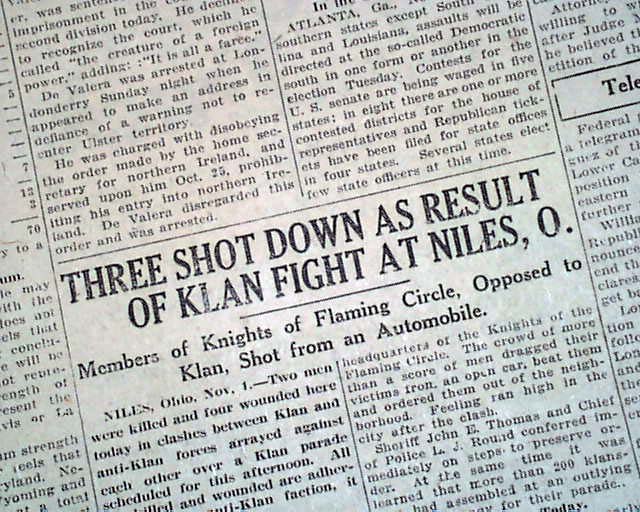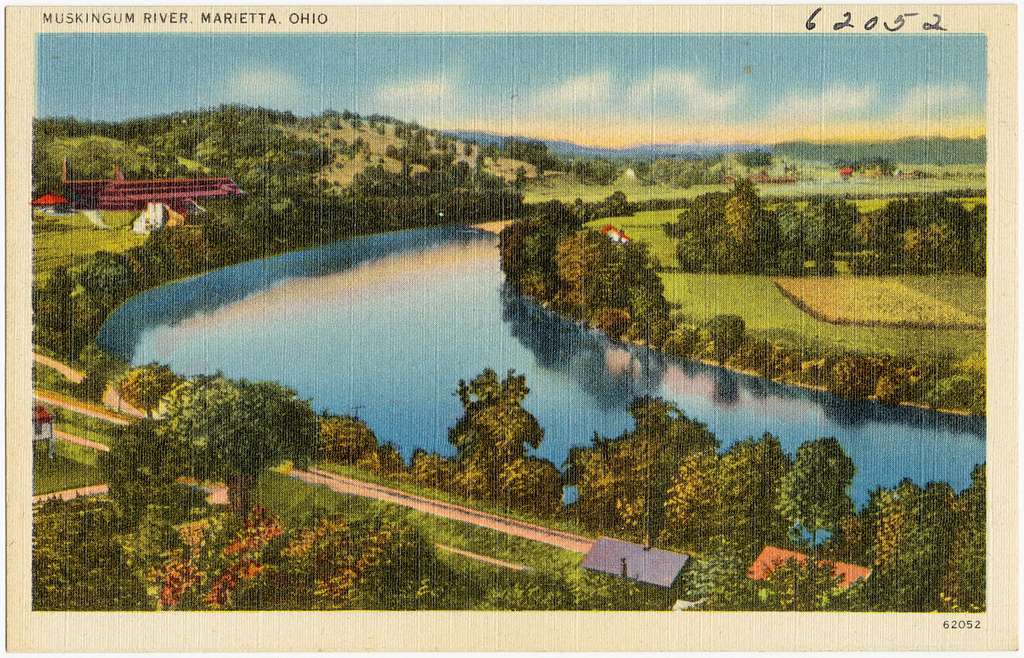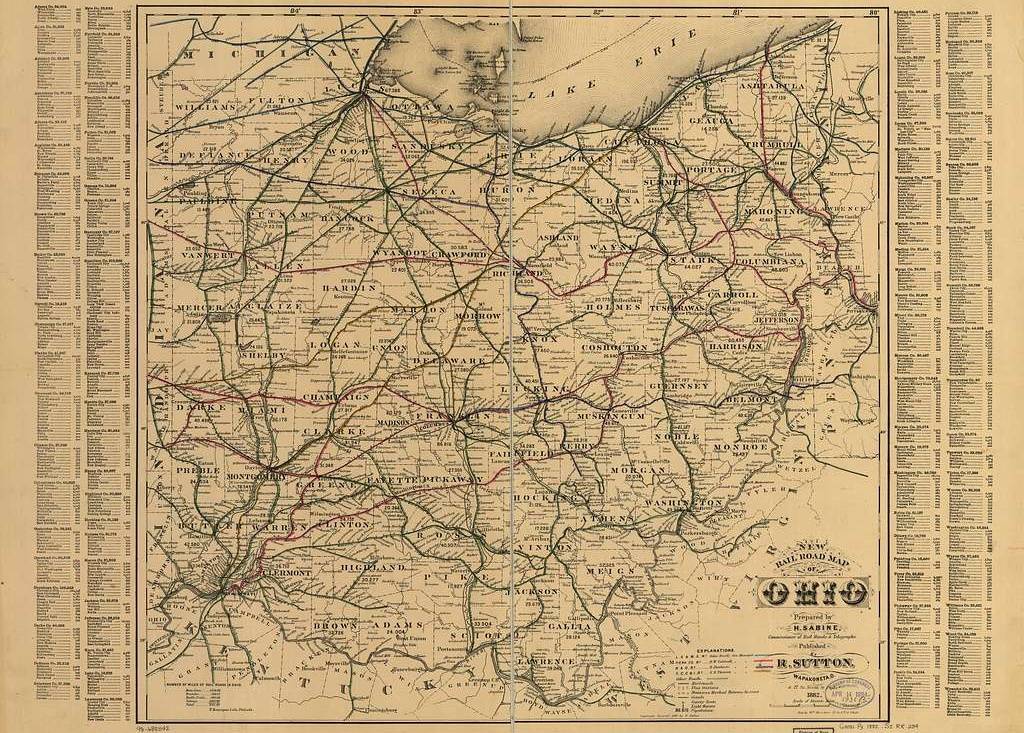In history, there has been no group as polarizing as The Klu Klux Klan, the far right-wing group promoting white supremacy, anti-Catholic, anti-immigrant, antisemite, homophobic (among other) ideologies. Across nearly all forms of media, we can see examples of Klan behavior, we can hear their speeches, watch as they don those white hooded robes they are known for and burn crosses that are meant to scare and intimidate those they do not like. Due to the popularity of the Klan, I’ve always wondered why there wasn’t an opposite group – one that went against everything the Klan stood for – but then I learned there had been one all along: The Knights of the Flaming Circle.
And they had a couple of interesting moments in Ohio history…
How The Knights of the Flaming Circle Began
It’s August, 1923, and dentist Dr. W. S. McGuigan of Niles, Ohio, is not a happy man. The Klan had been doing their thing in his part of the state, and there had just been a rather nasty riot a little south of him in Steubenville, so he felt like it was time for him to act. He was an Italian immigrant, which at the time was one of the main targets of the klan, and at the time, a good portion of the public didn’t seem to care for the italians, either. But, it was the Klan who seemed to be not only the loudest Anti-Italian voice – but also the most vicious.
He called his group The Knights of the Flaming Circle (itself a bit of a diss against the Klan’s practice of burning crosses) and it was going to be everything the Klan was not. (Kind of.) For example, while the Klan had a multi-level membership structure complete with title names and all, he declared that everyone would be equal within the group (except for himself, I guess, when he named himself “The Grand Supreme Monarch” (again a jab at the Klan’s Grand or Imperial Wizards).
While the Klan had a set of rigid membership requirements (no immigrants, especially Irish and Italians, must be protestant, white, etc…) The Knights would welcome everyone into their group, except for those who would qualify for membership into the Klan). While the Klan wore white robes and covered their faces with hoods, the Knights wore pure white robes with red circles and an image of The Statue of Liberty and would leave their faces uncovered. Whereas the Klan was known to burn crosses on the lawns of those they were targeting, the Flaming Circle would burn tires in the yards of those in the Klan (just in case you wondered where that whole “flaming circle” thing came from).
The Knights quickly spread out from the Niles area and within weeks new chapters were initiating members all across the state. And there was one town where things were about to get real heated, real quick: Steubenville.
Steubenville, 1923
The town of Steubenville, not terribly far south from Niles, seems like it should be two towns. One side of town is mostly white protestants, many were former military who were given land grants after a period of service and a lot of them didn’t seem too welcoming to foreign immigrants (German, Italians, Irish, etc) and this was exactly the kind of people the Klan were looking to recruit.
The other half of town was largely Italian, plus some Irish and a few Germans, most of whom were Catholic. That side of town also featured underground gambling parlors, which was also a really good place to buy some Moonshine or sell your bathtub gin. All of this was exactly what the Klan was targeting at the time. When word got out that The Knights of the Flaming Circle were a thing now, many Steubenville residents wanted to join their ranks.
On September 27, 1923, their initiation ceremony went off with a bang. A really big bang. The kind you get from more than just a few sticks of dynamite. And, on top of a hill just off the Ohio River, a large flaming circle. They were wanting attention and attention was what they got.
By August 15th, things in Steubenville had been escalating. Klan members from Virginia were coming into town, making their presence known, and burning a few crosses every few days. The Knights, likewise, were burning tires outside the hotels where the Klan were staying, you get the idea. Several groups of Klansmen decided that day to come into town and confront the Catholics, shut down the gambling halls, dump all the liquor into the river, and take back the entire city.
That night, the various Klan factions met at a hotel for dinner, and the knights were ready. As several groups of knights overturned the Klansman’s cars, others started throwing oil-soaked rags stuffed into bottles and setting ablaze into the restaurant itself. Before you know it, at least three thousand people were rioting in the town of Steubenville. Three Klansmen burned a cross in the yard of one of the Knights, then set his house on fire, too. A few hours later, two Klansmen’s homes found themselves with flaming circles outside their houses too, which were likewise on fire.
Somehow, not a single person died during the Klan-Knight riots, but there were quite a few people injured and there were plenty of arrests, too.
Niles, 1924
The following year, back in Niles, the KKK applies for (and gets) permission to hold a rally. This did not go over all that well with the Knights, so they applied for a rally permit too, but they got denied. I should probably note here that the office that grants the permits is almost entirely staffed by Klansmen, the Chief of Police was in the Klan, the Mayor was in the Klan, heck most of local government was in the Klan, so it’s not hard to imagine what the Knights were thinking.
It was clear that the Klan was gearing up to fight, the Knights were gearing up for a fight, and everyone was nervous, to say the least. The Knights urged the city to revoke the Klan’s permit, saying they should have granted both permits or none at all. When the city refused to budge, the Knights decided it was time to burn a flaming circle on the mayor’s house, which subsequently burned to the ground.
The Knights called the Governor seeing if he could do anything to stop the Klan rally, and if they couldn’t stop it could the Governor send the National Guard to help out…. On the same day, Klan organizers called the Governor to see if he could stop the Knight rally, and if not could he send out the National Guard to help police things… And, the governor wasn’t having any of it. He told both groups they were on their own and they needed to control their own rallies and if anything got out of hand, he was going to hold them both, personally, responsible.
The resulting rioting lasted about eighteen hours before martial law became the law of the land, which lasted about ten days.
History Was Nearly Forgotten
While the KKK had a long, sordid history, the Knights of the Flaming Circle only seemed to exist for a relatively short period of time. It never existed long enough to gain an established reputation, or a large enough group of followers. But, that’s probably not the reason the group was nearly forgotten by history.
First off, we need to remember that The Knights of the Flaming Circle was, in many ways, just as bad as the Klan was, in terms of violence, burning people’s houses down, and just being a menace to society. Part of me wants to give them credit since they were an anti-Klan group who attempted to stand up for all those the klan seemed to suppress, but as the two groups used the same methods, it’s hard to say that.
The Knights also operated at a time when, nationally speaking, Italians weren’t always welcome. Before the 1930s, Italians in America were not even considered as “white” and even after, they were categorically discriminated against because of miscategorizations associated with organized crime.
It wasn’t until (much) more modern times that this period of history (and, in particular The Knights of the Flaming Circle) were given any historical attention, mostly because of the group’s connection with Italians (but also because of the Klan’s infiltration of power units, such as police, universities, and various branches of government).
Dig Deeper
- Wikipedia – Knights of the Flaming Circle
- The Next Eclipse: Introducing the Knights of the Flaming Circle
- Beneath the Smoke of the Flaming Circle
- America may not perish : the Italian-American fight against the Ku Klux Klan in the Mahoning Valley
- The True American’s Triumph: The Mahoning Valley Anti-Klan Movement



